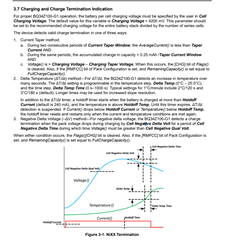Other Parts Discussed in Thread: BQ34Z100
Tool/software:
Hello,
In preparation for perform a learning cycle I have been reviewing the Application Report SLUA903 “Achieving The Successful Learning Cycle” (https://www.ti.com/lit/an/slua903/slua903.pdf). According to this document, during the portion of the learning where the pack is charged to full, the gauge must be able to successfully detect charge termination.
"At the end of charge the [FC] bit in the Flags() register should be set automatically. If it did not set then a full charge was not properly detected and the learning cycle fails."
For the purpose of the learning cycle I can use a charger that tapers the charge current at the end of charging so I should be able to supply the conditions necessary for the gauge to detect charge termination at full charge. However, in my end application the charger we expect to use will not taper the current. It will simply turn off the charging current once the pack voltage reaches a defined threshold.
My question is, will the gauge still function properly if used with such a charger (i.e. if it will never see the conditions necessary for it to detect charge termination)? From what I have read about the Impedance Track algorithm I can’t tell if the algorithm uses (or requires) that capability during operation of the pack. The pack that I am using is made up of 8 series LiFePO4 cells.
Thank you,
Steve


